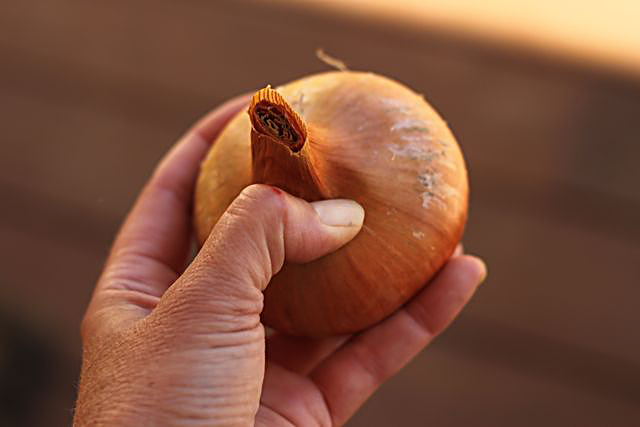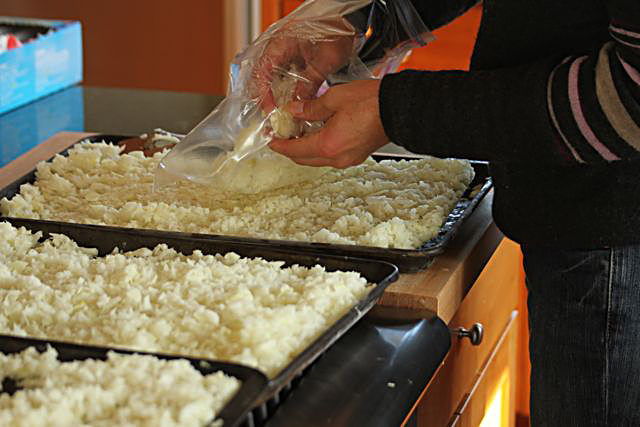I thought it was worth re-visiting my original Apple Rosemary Jelly Post, since I have been making a lot of it this past week and have been experimenting with the amount of sugar necessary for a good gel. That recipe has generated a lot of comments and questions from people who want to make a lower-sugar jelly and I really didn’t have any answers at the time.
And, to be fair, I still don’t really have ANSWERS so much as solid experience that says using less sugar should work for you, since it has consistently worked for me. To make the jelly, be sure to read the original post for the recipe and directions. For lower sugar, read on!
The base of the problem is that jams and jellies are all about food science. I have neither the time nor the inclination to do the full research on the subject. I just want jams and jellies that spread. I want to make it once, not two — or God forbid — three times. I did spend time delving into the subject online to see if I could understand how the amounts of water, sugar, acid and natural pectin affect the end product, but alas, I am not much more informed than I was when I set out.
What I WILL say, is that I am so VERY sick of reading about the USDA standard for jams and jellies and all kinds of nonsense. I’m not a proponent of putting anyone’s safety at stake, however, I surely beg to differ that you need to use a box of Sure-Jell. Good grief. Have you read those recipes? Four cups of juice to eight cups of sugar… and I rest my case.
The bottom line is that you can cook just about any fruit down to a spreadable consistency with very little sugar. Period.
Jelly is a little trickier.
So this is what I’ve learned: 220 degrees is the magic gelling temperature — as stated in my original apple jelly recipe. Just to compare, I checked the temp of my raspberry jam when done (using my normal sight and sound cues described here) and it was also 220 degrees! I thought that was pretty cool.
I’ve noticed that using less sugar for the jelly takes longer to reach that temperature. I’m not sure if the longer cooking time is a factor of how much water is present in the juice or from the reduced sugar. I just don’t know. At any rate, you also end up with less end product when you use less sugar (obviously). What gets my brain running in circles is this: Is it possible that by the time you reach 220 degrees, you’ve boiled off enough water and juice to have the same amount of sugar to apple juice in the finished jelly? My dad, a food scientist in his working days, says no. But then, it’s my dad. And I have a long history of not believing him. So why start now?
Ha ha ha. I love to tweak on my dad.
Anyway, that’s the scoop. My former Apple Rosemary jelly used a 1:1 ratio of apple juices to sugar. 4 cups juice, 4 cups sugar (which is still low sugar, when compared to commercial pectin recipes). My 2013 jellies have used ratios of 2:1 all the way to 4:1 juice to sugar. And they have all worked. I like to think the jelly is lower sugar, but I can’t say that it is for sure. What is truly amazing though, is that the lower sugar jelly tastes just as sweet. The only difference that I can detect is that it tastes more “apple-y”! Cuz, duh, I’m not a martyr. I still want my jelly sweet…
For all the questions this will generate (and, no doubt, sad stories of failures) Here are some visual clues to the point at which your jelly will set.
When it is in the early stages and boiling hard the mixture is foamy, like bubble bath.
After a while the bubbles start to get shinier and slightly darker
It takes a long time to go from 216 degrees to 220 degrees. But once it hits 220 degrees, look out! It will rise quickly and you want to get it off the heat and in to hot, sterilized jars quickly. As you can see, in just the time it took to focus my camera, the bubbling mass went up almost 2 degrees!
At the end, the mixture it is dark and shiny and sort of ANGRY looking.
10 minutes in a water bath will complete the process and leave you with with jars of joy that should definitely be left out on your countertop (preferably in a window where you can enjoy the beautiful color) and pat yourself on the back every time you glance their way.
It’s been a long few weeks of harvesting, canning and freezing tomatoes, picking sorting and cooking apples. Picking carrots and beets. Making beet chips — the ONLY way I can tolerate a beet, I might add. Picking and hauling pumpkins and squash. Next up is kale, kale and more kale, along with washing my dreaded windows. All of that will have to wait though, as I am planning to zoom off to Madison for the weekend for some retail therapy with Morgan. Yes, I do hate to shop, but Morgan does not!
























































